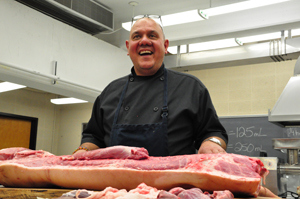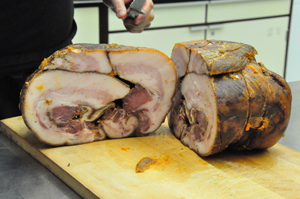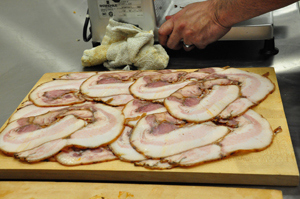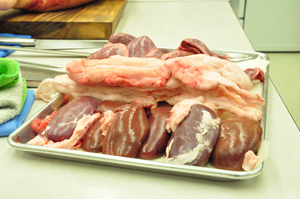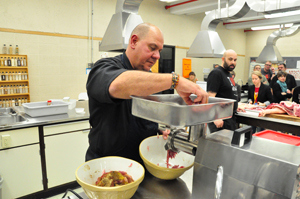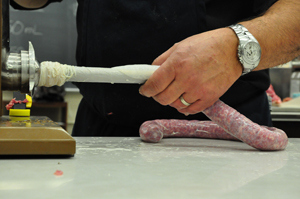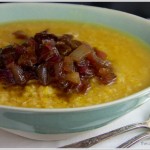Recently I had the opportunity to attend a workshop at the Devour Food Film Fest titled from Nose to Tail. As the name would suggest, the workshop detailed how to use all of the parts of our fine furred friend, the pig.
Typical of the high caliber Devour experience the workshop was facilitated by two foodie heavy hitters, Scott Vivian of Beast in Toronto and Chris Vilden of Flying Apron Cookery in Tantallon. Their dedication to healthy and humane food was palpable, and their instruction second to none.
While the images in this blog post may appear gruesome, the workshop facilitators expressed a respect for the animals they worked with, a genuine concern for the conditions in which they were raised, and a keen interest in avoiding unnecessary waste. Repeatedly the chefs referred to the connection between the humane treatment of animals as it translates to the quality of the meat we consume. The general reverence the chef’s espoused for the animals they dealt with was admirable and set a standard for others to follow. While this approach may seem novel to fledgling foodies like myself, this common-sense behaviour has been the norm in most cultures, including our own, until recently. Their work encompasses a passion for helping eaters rediscover the skills and knowledge necessary to enjoying the forgotten treasures of our shared food histories.
The workshop started from the head and worked its way backwards to the hindquarters. The chefs demonstrated how unlikely portions of the head, such as the ears and the snout can be integrated into a dining experience. Next, by removing layers of flesh and fat from the head, chef Vivian demonstrated how they could be brined, cured and bound to resemble a pancetta. Sliced and served as succulent appetizers, this first example made it evident just what we’ve been missing in choosing only the most common cuts and the crushing tragedy it is to discard them or to feed them to our pets. Sorry Rufus, the head bits are all mine!
Of the more obscure cuts we explored was the offal. The offal is basically the innards of the pig: heart, liver, kidneys, fat and so on. Displayed on a somewhat macabre platter, their uses were described to us one by one. Whether used in baking, for the base of a stew or stock, for grilling or preparing pate, each had uses far beyond the imagination of many in the audience. While some might have begun the workshop a bit skeptical, I would guess that most were intrigued to introduce a little more adventure into their kitchens by the time they had left.
As we traveled down the carcass, the chefs skilfully exposed more recognizable cuts hidden beneath a thick layer of lard. The ease with which hunks of flesh were transformed into elegant cuts of meat made onlookers truly appreciate the artistry involved in butchering. The front shoulder bequeath the roasts, ground pork for sausage, kielbasa and fatty bits for stew meat. The hocs, or feet, provide the base for soul food soups and stews. The belly grants us several bacons, ribs and other mouth-watering delights. The back exposes the loins and chops, so popular to many, but of little interest to our chefs. Moving into our butt ends and hind shoulder we find the hams that adorn our holiday dinner tables and the delights used to prepare prosciutto and other cured meats.
Finally, we closed the workshop by preparing some sausage from the front and hind shoulders, which give us the perfect balance of 20% fat to 80% meat. Again using the intestines of the animal, as opposed to industrially fabricated tubes of who-knows-what, we employed all of the wealth the animal had to offer. Scott and Chris seasoned the sausage lightly and walked us through the process of tubing out our sausage. Within minutes the links were sizzling in a frying pan as we all watched in anticipation. Once prepared, they were served on a bed of homemade sauerkraut and mustard prepared by Flying Apron. The end result was exquisite and left us all wondering whether we would get a sampler of the rest of the pig on display.
While one might construe this type of workshop as a glorification of slaughter and decadence, I was left with quite a different impression. I personally felt a sense of curiosity about just what cultural food legacies we’ve left behind in the pursuit of mass produced factory cuts, and hyper efficient supply chains. I was also left with a respect for the importance of the butcher as our intermediary to producers and a source of knowledge all but lost for most of us. As well, I felt a tinge of responsibility to eat with greater tenacity, the parts which we so often choose to ignore.
As a reflection on my own work, it also made me consider those people in our own communities who still possess this knowledge. Opportunities to explore these skills and knowledge don’t only exist in the hands of chefs and foodies – they are well practiced and employed by our elders and newcomers to Canada. Finding ways to transmit this information across generations and cultures is in part the work we try and support with the Our Food Project. As I continue to learn, I promise to share more.
Author: Will Fawcett Hill. Community Food Programmer, Ecology Action Centre
Photo Credit: Michael Stack. Thank you for these fantastic images.
Email: stackmedia@eastlink.ca
Twitter: @mjstack.
Special Thanks to Devour Food Film Fest Organizers and Volunteers for a Great Event!


